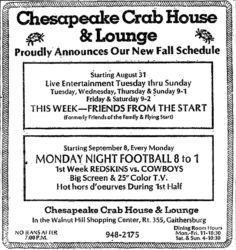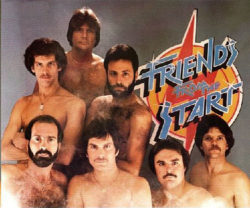Pete Margus retired in October after 30 years in the wine business. The Takoma Park native lives with his wife in Selbyville, Delaware, near Ocean City and far away from the stress of working life. Especially during the coastal town’s offseason, he says, “it’s a very simple, uncomplicated lifestyle.”
It wasn’t always that way for Margus. There was a time that he wouldn’t think twice about wearing a flaming red wig and playing guitar onstage in a Ronald McDonald costume. That outfit — deployed during a medley of TV-commercial music — was one of many he wore when he performed with his band Friends of the Family in the ’70s.

The band Inspiration, in another photo posted on the DC Bands from the 70’s group on Facebook.
The fast-food-clown getup was hardly the most outrageous thing in the band’s wardrobe.
“Spandex and satin were pretty happening at that point. Once we did a Queen medley and a couple of the guys had capes that had hundreds of lights inside,” says Margus, 65.
In an early photo of the band, its seven members are wearing matching white suits, each adorned with colorful floral patterns made by a man who designed costumes for KC and the Sunshine Band. Caught in what appears to be mid-strut, the band is smiling.
“If I put that on today, I’d get arrested,” Margus laughs.
The outfits worn by Friends of the Family are unforgettable. But the band and its community are little remembered. In an era when walloping hardcore punk and hip-shaking funk were the loudest sounds emerging from the nation’s capital, there was a shadow scene of flamboyant and popular cover bands that played at long-forgotten venues in the Washington suburbs.
These were show bands. They were typically all-male, and often racially integrated. The types of variety shows they staged weren’t exclusive to the Washington area, but the scene was particularly vibrant in suburban Maryland, Baltimore and Ocean City. Like many cover bands, show bands included accomplished musicians who dreamed of making a living with original material. But to make ends meet, they played nights full of Top 40 hits at nightclubs and hotel bars. Making it on that circuit required, at a minimum, versatile musicians who could easily satisfy audience requests for Styx and Billy Joel, “Freebird” and “Stairway to Heaven.”
The bands that stood out had something more to offer, though: Comedy skits. Magic acts. Stunts. Friends From the Start, another of Margus’ bands, brought a gallows on stage for a cover of Alice Cooper’s “Welcome to My Nightmare.” Bandmate Rick Davis was the lucky member who got to hang during the song.
“We went through all kinds of testing with this thing,” Margus remembers. ”We had him hooked up with harnesses and had the noose so when the hatch pulled he actually wouldn’t hang, but we had him hooked up in the back on bungee cords so it would look like he was hanging.”
Tiny Barge and ‘shooter sets’
Some of the history has been collected by Michael Weiland, who was in the bands Confection, Springfield and Redemption. He operates the Facebook group DC Bands from the 70’s, which features colorful promotional photos of groups represented by the Washington Talent Agency and Barry Rick, once prime movers in the scene.
Prominent bands played as many as five sets a night, six days a week. The most successful groups made $6,500 a week, which would be $20,000 today. One of those sets would be a floor show.

Friends From the Start members Rick Davis and Pete Margus perform at Mr Pip’s in Glen Burnie, Maryland, in an undated photo.
“For the most part bands sat on stage and people were on the dance floor,” explains Arthur Leon “Tiny” Barge, a musician and promoter who developed floor shows for bands while he worked for the Washington Talent Agency. “These were a special presentation where the audience would take their seats and the band would be on the dance floor.” Floor shows were an added attraction for patrons out to see live music. A band that played six nights a week might only do floor shows on two of those. On Thursdays, floor shows drew patrons into clubs on a slow night. Saturday nights, they whipped up a party.
The show-band scene owes much of its success to Barge. A composer who could sing and play multiple instruments, he was a founding member of ’60s D.C. soul group the El Corols, the first band signed to the fledgling Washington Talent Agency. The group’s knack for showmanship made it a hot commodity — so much so that while Barge was still a student at the University of Maryland in the early 1970s, the company had him coach other acts in choreography and audience interaction.
“We were prostitutes. We had to play what they heard on the radio. We sold liquor. If they sold more liquor that night, the band would come back.” — Bob Farris, show-band guitarist
Barge helped show bands pace their sets and warned against habits that hampered audience engagement, like drum solos. Mimicking a solo with his voice, he explains how an audience will stop clapping if unaccompanied drumming continues past a reasonable point.
Kent Harris, singer with the show band Springfield, credits Barge with taking a bunch of white guys and teaching them to dance. “We were idiots!” Harris says.
The most successful show bands could perform, in addition to Top 40 hits, a live variety show that kept customers coming back to the nightclubs. And kept them drinking.
“We were prostitutes,” says Bob Farris, who played guitar in a number of show bands. “We had to play what they heard on the radio. We sold liquor. If they sold more liquor that night, the band would come back.”
Friends From the Start even had what it called a “shooter set,” where customers would send the band trays of lemon drop, apple pie and lime shooters. “People wanted to see if they could get the band wasted, and it happened more than a few times,” Margus says.

A newspaper ad from September 1980 featuring Friends From the Start’s multi-day schedule at Chesapeake Crab House & Lounge in Gaithersburg, Maryland.
Show bands played venues like the Classics III Supper Club (now the Classics) in Camp Springs, Club Venus in Baltimore, Mr. Pip’s and Bojangles Too in Glen Burnie and Randy’s California Inn, which currently sits abandoned at the intersection of Route 1 and Whiskey Bottom Road in Laurel. (There were occasional gigs in Virginia, too.)
Sometimes a show band had a good idea but not good timing. Harris, who sang in several bands with Margus, recalls a plan he had hatched with his band, MacArthur Park. “We were getting ready to do a disco version of ‘MacArthur Park.’ We had an excellent female singer, a little like Chaka Khan. Then Donna Summer came in and did a version.” That version became Summer’s first No. 1 hit on the Billboard Hot 100. MacArthur Park never recorded its own version.
Despite that missed opportunity, Harris, who also booked and managed acts for the Washington Talent Agency, had other good ideas.
“I went into the Rockville Ramada, which is now a Comfort Inn off of [Interstate] 270. And there was a piano thing going on, a single act. There were only a few people there, and I thought, there’s no club activity at all around here — there’s no place to go. I got together with the general manager to start a band and I told him we’re gonna blow this place away.”
Because Harris was also a talent agent, he had access to top local musicians. “We started doing entertainment there, and the place went crazy — people lined up all the time. There were people standing in the back and one Saturday night the fire marshall was there, and I had to stop right in the middle of a floor show.”
All of that energy and showmanship also led to some ideas that are politically incorrect by today’s standards.
“We did a takeoff on the Jackson Five,” Harris says. “We were the Jacksons but instead of Michael we were Stonewall Jackson and Andrew Jackson. There were things that today you couldn’t do.”
Changes in the grind
When Barge left the East Coast for Chicago and points West, he brought the show-band aesthetic with him, but while some bands adopted the variety show format, it didn’t take off as much as it did back east.
Show bands thrived through the 1970s and mid-1980s, and while some of them still perform as wedding bands, the show-band business model had faltered by the dawn of the ’90s. What happened?
“I was in was the band Bittersweet almost 15 years doing as many as 50 jobs a year. We opened up for Bill Cosby, Fifth Dimension, Ray Charles, Barbara Mandrell. Then it was just wedding bands, bar mitzvahs and company parties. Some of the players had graduated into that,” Margus says. “Then you’re playing the circuit for years, with no recording contract, and you’re on the road six days a week, married with kids.”
Other factors led to changes in the scene: DJs became more popular, and they charged less than a live seven-piece band. But many show-band players say the law interfered.
“In those days,” Harris says, “People would go out any night of the week. When DUI laws went into effect in the ’80s, people would not go out as much. The budgets just collapsed.“
Farris, who performs to sold-out audiences today as part of local rockabilly legend Johnny Seaton’s band, recalls that in least one case, clubs pulled the plug on show bands too soon. He had a regular gig in a popular oldies band at the Pooks Hill Marriott in Bethesda, when one night in the early ’90s a waitress informed him that the venue was closing. It was to be converted into a corporate replica of the bar from television series Cheers.
“I went back there when it opened on a Friday night,” Farris remembers, “and there were three people at the bar, period. There was a stuffed animatronic Norm and Cliff. Cheers was playing on eight different televisions. Three people at the bar. That was the end.”



